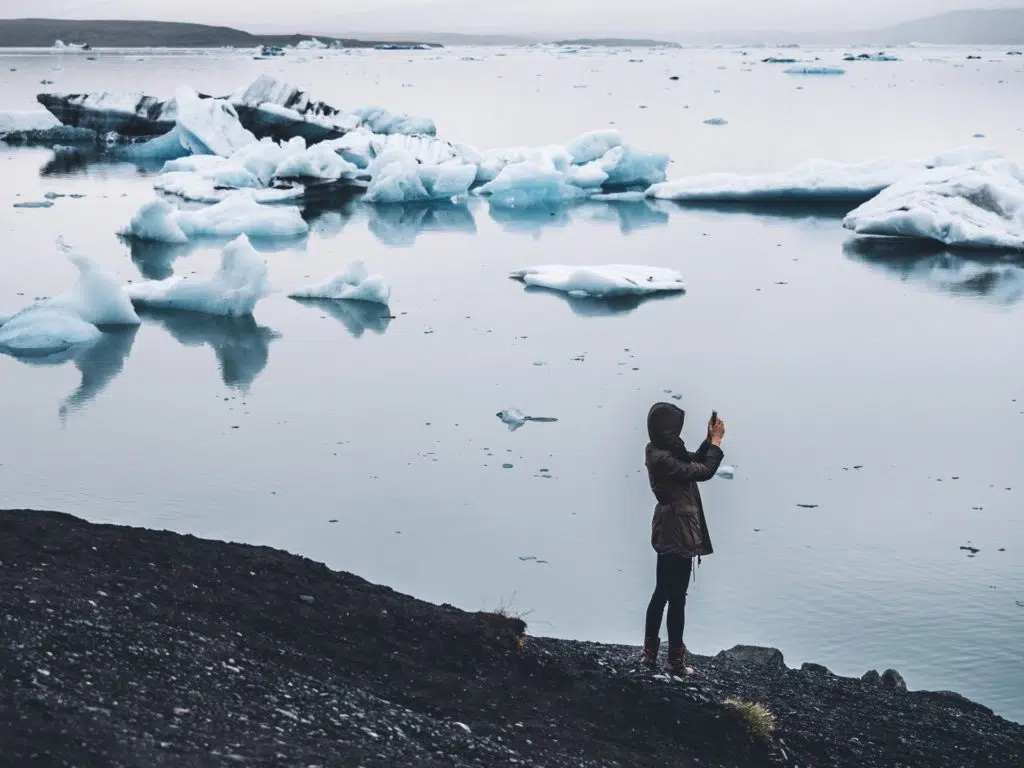Fourteen tips on how to dress in Iceland
How to dress for Iceland? I get this question a lot, and it is understandable. Iceland’s volatile weather is world-famous. Here are fourteen tips on how to dress for Iceland.

Tip 1: Expect the unexpected.
A well-worn phrase about the Icelandic weather is ‘Don’t like the weather? Just wait five minutes.’ Whoever came up with that phrase forgot to add. ‘You might dislike it even more than, so be grateful for what you got now.’ The answer to how to dress for Iceland can perhaps best be answered with this bit of anecdote. I was hiking the Laugavegur trail in high summer. I had a large backpack with clothes for every contingency. The worst thing on hikes in Iceland is cotton or denim. These fabrics absorb water and are cold and have contributed to the death of inexperienced hikers who venture out in the Icelandic highlands dressed like they are strolling down the main street of Disneyland. Well, Iceland isn’t Disneyland.
Tip 2: Rent instead of buying
Reduce the hassle of packing bulky clothes to Iceland. Rent from from Icelandic Cover instead. Remember that by signing up for the Stuck in Iceland Newsletter you save 10% off the rental price.
Tip 3: Dry fit fits Iceland
On my Laugavegur hike, I used every item of clothing in my backpack, every day, many times. So perhaps, I started in the early morning in cold, high wind, and driving rain. Underneath a waterproof shell jacket, I had a dry-fit t-shirt and a dry-fit sweater. I wore sturdy hiking boots, woolen socks, shorts, dry-fit hiking trousers, and softshell trousers. I had a shirt made from Icelandic wool in my bag for those cold nights. Then an hour later, the sun was out, and the wind died down. It became a race to get out of these layers, and I was down to my shorts and t-shirt. My backpack got stuffed with all the protective clothing. And so on.
Tip 4: Icelandic wool is a magical shield of heat
I also remember being on the Vatnajökull glacier when a robust northern wind hit us, and people were hunkered down, waiting to see if we had literally to crawl down because of bad weather. But I took out my Icelandic woolen sweater and put it and put my windproof jacket on over it. It was like being cloaked in a shield of heat. Waiting it out on the windswept and barren glacial plain until things calmed down was just fine by me.
Tip 5: Explaining layers
We are going to talk about layers a lot. But what does that mean? Well, layers are simply the method of wearing many clothing items instead of just one or two. So for example, if you are going on a hike, you might wear some very thick trousers which you hope will protect you from the elements. But this might be a mistake. You might be OK, to begin with, but then things start to heat up. You will be super hot and drenched in sweat, and as a result, you will not get any joy from your hike. A better method would be to wear woolen underwear which breaths. Also, wear Thin dry-fit shorts, dry-fit pants, and then an outer softshell which dampens wind and protects against rain. All of these items ‘breathe,’ reducing sweating.
If things heat up sufficiently, you can ditch your shell and trousers and show off your beautiful legs.
We are not all hiking across glaciers or the highlands. But in general, think about the following when packing clothes for Iceland.
Tip 6: Treat your feet right
In Iceland, you want to be wearing waterproof shoes and boots. If you are going on a hike or joining a tour to a glacier, I recommend sturdy hiking boots and quality hiking socks. Never go on an Icelandic glacier alone. Join a tour with an experienced guide. Make sure you have broken your hiking boots in before going on hikes. Never use brand-new hiking shoes on a rigorous hike. Avoid sweating to prevent blistering. Pro-tip. Consider wearing blister bandages on your trek to avoid blisters on toes and heels.
In winter, if you are coming to Iceland, expect things to be snowy, cold, and wet. In summer, just be prepared for a little less cold and wet! It is good to wear trail running shoes when you are getting around in summer. Of course, hiking boots would be complete overkill for a summer road trip.
Tip 7: Trousers
Yet again, think layers. You will need protection from wind, rain, and cold. In winter, add snow, frost, and sleet into the mix. Avoid jeans or anything made out of cotton when hiking. Wear waterproof softshell trousers over dry-fit trousers.
Tip 8 on how to dress for Iceland: All about jackets and sweaters
A good down jacket is essential for winter. These long nights where you are hunting for the northern lights are freezing! I also like woolen sweaters or sweaters made from dry-fit fabric. In summer you want jackets that are water and wind-resistant.
Tip 9: Be seen all night long
Please wear reflectors if you are out and about in the dark Icelandic winter.
Tip 10: Keep your extremes warm. Wear gloves, socks, and hats
I would always keep gloves and hats handy. Don’t wear leather gloves. They look good, but I find them to get cold, especially in winter. I would go for rugged and water-resistant gloves. I advise against cotton socks for long walks or hikes, especially winter.
Use woollen socks instead. It is an excellent option to bring hiking socks. Have backup gloves, hats, and socks if things get wet. I like to wear dry-fit shorts for those trips to swimming pools, baths, and spas here in Iceland.
Tip 11: How to dress for Iceland if the sun is out?
Yes, the sun does shine in Iceland, and like most things here, it can get a bit extreme. In fall and spring, the sun is low on the sky, and this can cause drivers to be blinded. So bring sunglasses to Iceland! And if you are on a glacier and the sun is shining, please make sure that you apply sunscreen and a lot of it. The white surface acts as a magnifier for sunlight. The sun is also intense in summer, so bring sunscreen and sunglasses, count your blessings and enjoy!
Tip 12: How to dress in Iceland when going out on the town in Reykjavik?
Just wear your regular clothes but remember you need to stay warm. You are not ascending to a glacier, although the weather can get ‘interesting,’ of course. Remember, you may not want to look like somebody going up on the Vatnajökull glacier on a Saturday night in downtown Reykjavik. Icelanders like to dress up smartly when they are on the town. Blend in if you can!
Tip 13: Crampons can be a good safety gear in Iceland during winter
People often ask if they need crampons. If you are visiting in summer and not going anywhere near a glacier, the answer is no; you don’t need crampons. And you should never go alone on an Icelandic glacier anyway; they are death traps for the untrained. Travel companies always give their customers crampons if they are going up on a glacier, so you are covered. If you are hiking or walking long distances in Iceland in winter, you should consider having crampons handy. If you visit a waterfall such as Gullfoss, Seljalandsfoss, Gljúfrabúi, or Skógafoss in winter, watch out for icy conditions, and crampons can be a good safety gear. They can also be good if you explore a place like Thingvellir in winter because it can get very slippery. Crampons are, however, rarely needed if you are strolling around Reykjavik.
Tip 14: Get weather forecasts in Iceland on your phone and stay safe!
Follow the weather reports and forecasts at the Icelandic Met Office when in Iceland. Always follow the advice given on the Safe Travel website.

